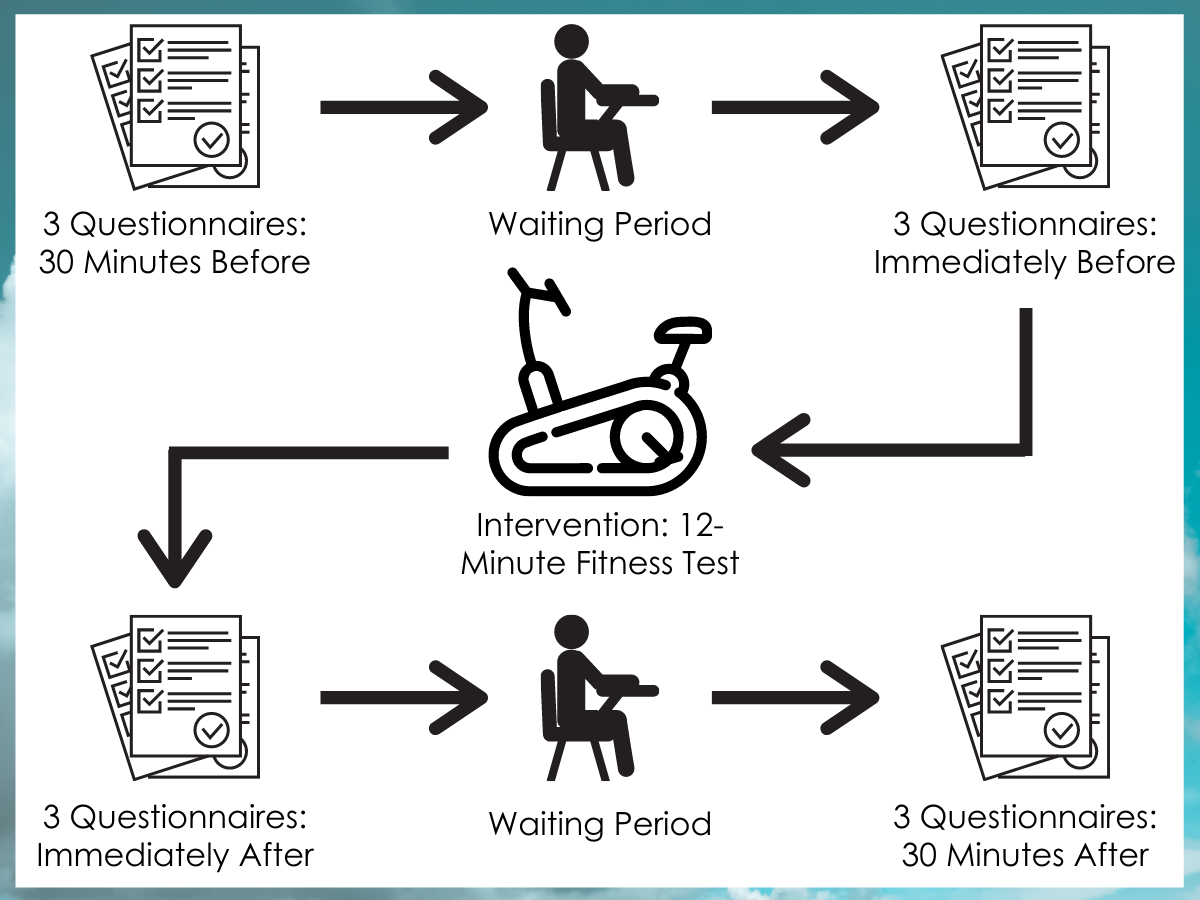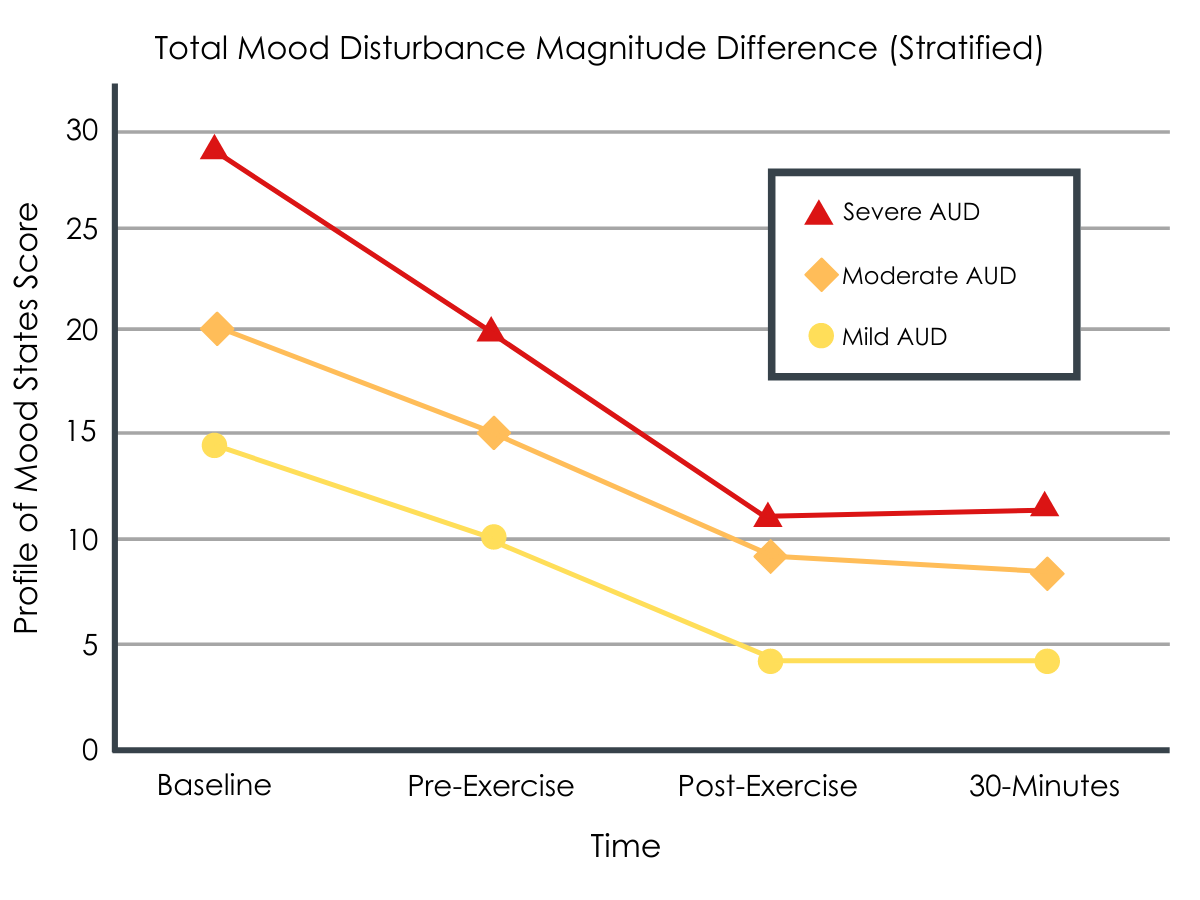Exercise has many mental health benefits, but can it reduce craving and negative mood in active alcohol use disorder?
Exercise, even in short bursts, has long been appreciated for its capacity to reduce anxiety, depression, and stress. Exercise, too, may help buffer aversive emotional states like anxiety and craving in individuals with alcohol use disorder. In turn, these reductions in anxiety and craving could improve drinking outcomes. In this study, researchers examined how brief bursts of exercise might help individuals with alcohol use disorder from the community.
WHAT PROBLEM DOES THIS STUDY ADDRESS?
Numerous studies of both brief and longer-term exercise-based interventions reduce depression and improve quality of life and physical health across a range of psychological conditions, but questions remain about the potential benefit of exercise for alcohol use disorder. In theory, acute bursts of exercise could help to diminish alcohol cravings in-the-moment for individuals alcohol use disorder, while also reducing negative mood states that may ‘trigger’ drinking or increase the risk of relapse. Two previous studies (see here, and here) with treatment-seeking individuals with alcohol use disorder suggest brief bursts of exercise can reduce craving and negative mood. In this study, Hallgren and colleagues focused on acute benefits of exercise for individuals with alcohol use disorder to build on these prior studies in treatment-seeking individuals.
HOW WAS THIS STUDY CONDUCTED?
This was a single-arm trial with 140 participants who received four sequential assessments of alcohol craving, mood states, and state anxiety, taken 30 min before a 12-minute burst of aerobic exercise (‘baseline’), immediately before (‘pre-exercise’), immediately after (‘post-exercise’), and 30 min after exercise (’30-minutes’). This study was part of a larger randomized controlled trial of physical activity as a treatment for alcohol use disorder conducted in Stockholm, Sweden.
Participants were recruited by a newspaper ad seeking individuals who, “exercised too little and drank a bit too much”. Participants were assessed for alcohol use disorder, and categorized as having either mild (2-3 symptoms), moderate (4-5 symptoms), or severe (≥ 6 symptoms) alcohol use disorder. Mood states assessed before, during, and after exercise included: 1) craving for alcohol assessed using the Desire for Alcohol Questionnaire (Swedish version), 2) negative mood measured with the Brief Profile of Mood States total mood disturbance index, and 3) state anxiety measured using the State-Trait Anxiety Inventory.
The exercise task involved cycling on a calibrated mechanically braked cycle ergometer for a total of 12 minutes without stopping between. Pedal frequency throughout the test was 60 rpm. Cycling resistance started at light work-rate. After 4 minutes, the cycling resistance was increased to a somewhat strenuous to strenuous work-rate based on the individuals’ strength. Participants continued cycling (without stopping) at the higher work rate for 7 min, with a 1-minute transition period between the lower and higher work rates (12 minutes in total).

Figure 1. Adapted from Figure 1 in Hallgren et al., 2021.
The sample (N= 140) was 70% female, with an average age of 53.7 (SD = 11.8). The majority of participants had greater than a high school level of education (69.3%), were employed (77.9%), and living with their partner (57.1%). The proportion with mild, moderate, and severe alcohol use disorder was 29.4%, 37.8% and 32.8%, respectively. Ten percent were current cigarette smokers and 22% used smokeless tobacco. The rate of combined overweight and obesity was higher (70.7%) than in the general Swedish population (~50%). The sample’s cardiorespiratory fitness was determined to be below the general population average.
WHAT DID THIS STUDY FIND?
The exercise intervention was rated as fairly strenuous for most participants.
During the last minute (minute 11-12) of the exercise intervention, most participants rated the exercise as ‘somewhat strenuous’ or ‘strenuous’. Mean heart rate during the last minute of exercise was 131 beats/minute (SD= 16.3). There were no differences in mean heart rate between those with mild, moderate, or severe alcohol use disorder.
Reductions in alcohol craving were observed.
Alcohol craving reduced significantly from pre-exercise to post-exercise, and 30-minutes, with small to moderate effect sizes. Between group contrasts revealed that the reduction in alcohol craving over time was larger among those with severe alcohol use disorder compared to mild alcohol use disorder.
Negative mood also reduced.
Negative mood reduced from pre-exercise to post-exercise, and 30-minutes, with small to moderate effect sizes. Group contrasts revealed that the reduction in mood disturbance over time was larger among those with severe alcohol use disorder compared to mild alcohol use disorder.
Anxiety was reduced but only at 30min post-exercise.
A small effect size reduction in state anxiety was observed from pre-exercise to 30-minutes following exercise. Group contrasts indicated there were no meaningful differences in reduction in anxiety between alcohol use disorder severity groups.
No sex differences were observed.
Women and men appeared to benefit equally from the 12-minute burst of aerobic exercise.
WHAT ARE THE IMPLICATIONS OF THE STUDY FINDINGS?
This was the first trial to explore the effects of an acute burst of exercise on alcohol craving, mood, and anxiety in physically inactive, nontreatment seeking adults with alcohol use disorder. Findings suggest that a short, 12-minute burst of aerobic exercise may acutely reduce cravings for alcohol, as well as negative mood, and anxiety. Relative to mild alcohol use disorder, the largest magnitude effects in reduction in craving and negative mood were observed in those with severe alcohol use disorder, though this could simply be a function of the fact that participants with severe alcohol use disorder had higher craving and negative mood at baseline, and therefore had greater room for improvement on these measures.

Figure 2. Total mood disturbance magnitude of difference (stratified).
While this study and two prior show evidence that bursts of exercise can address acute craving, anxiety, and negative mood, together studies on sustained exercise for alcohol use disorder to date suggest that exercise in and of itself does not lead to long-term improvements in depression, anxiety, self-efficacy, and alcohol consumption, though exercise may improve quality of life. At the same time, there may be some secondary benefits arising from exercise behaviors (e.g., increases in motivation, and sense of self-determination) that help individuals with alcohol use disorder reduce their alcohol consumption. Regular exercise in the context of alcohol use disorder treatment appears to also reduce depression symptoms and improved physical fitness, which could have positive ripple-out effects not quantified in these previous studies.
Even though the literature on exercise from alcohol use disorder is mixed, in terms of clinical application, this study, and two before it with alcohol use disorder treatment seekers, suggest that brief bursts of physical activity could help individuals with alcohol use disorder manage aversive mood states in-the-moment. It is possible that these bursts of exercise could disrupt cascading negative mood states, and in doing so prevent alcohol use relapse. Studies are needed that tease out the potential benefits of acute bursts of exercise to address momentary negative mood states, versus regular, daily exercise to improve global/protracted mood states.
- LIMITATIONS
-
As noted by the authors:
- This is a single-arm intervention study without a control group.
Additionally:
- Though this was a well-designed and well-executed study, there are limitations to the conclusions that can be drawn from its data. We cannot know, for instance, if the observed benefits of a burst of aerobic exercise persist beyond 30 minutes. Also, though craving, anxiety, and negative mood are well known precursors of alcohol use relapses in those with alcohol use disorder, we cannot know from this data whether the observed reductions in craving, anxiety, and negative mood subsequently led to reductions in alcohol use in this non-treatment seeking sample.
- This was a well-controlled, laboratory-based study. More research is needed to determine whether bursts of exercise can help individuals with alcohol use disorder under real-world conditions.
BOTTOM LINE
Individuals with alcohol use disorder participating in a short, 12-minute burst of aerobic exercise reported reduced urges to drink alcohol, as well as reductions in negative mood states and anxiety. These are promising findings that could inform future exercise-based interventions for alcohol use disorder. At the same time, more research is needed to determine whether these findings will hold-up under real-world conditions, and whether the observed short-term benefits translate into better recovery outcomes for individuals with alcohol use disorder. Additionally, there’s much to be learned about how different types of exercise might impact these various aspects of functioning and health behavior change.
- For individuals and families seeking recovery: Exercise is widely appreciated for its physical and mental health benefits, and findings from this study suggest that brief bursts of aerobic exercise can reduce craving, negative mood, and anxiety in people with alcohol use disorder. Though more research is needed to determine how far these benefits extend, given the global benefits of exercise, its general safety as an intervention (i.e., low risk of adverse reactions/side effects) and the fact it is free and accessible, mean exercise could be a useful addition to first-line alcohol use disorder treatments. Organizations like The Phoenix, who offer free exercise classes to individuals seeking addiction recovery may have a dual benefit of offering exercise, as well as peer-driven recovery support.
- For treatment professionals and treatment systems: Exercise is widely appreciated for it physical and mental health benefits, and findings from this study suggest that brief bursts of aerobic exercise can reduce craving, negative mood, and anxiety in people with alcohol use disorder. Though more research is needed to determine how far these benefits extend, given the global benefits of exercise, its general safety as an intervention (i.e., low risk of adverse reactions/side effects) and the fact it is free and accessible, mean exercise could be a useful addition to first-line alcohol use disorder treatments. Organizations like The Phoenix that offer free exercise classes to individuals seeking addiction recovery have a dual benefit of offering exercise, as well as peer-driven recovery support, and should be considered when referring patients to community-based mutual-help programs.
- For scientists: Exercise is widely appreciated for it physical and mental health benefits, and findings from this study suggest that brief bursts of aerobic exercise can reduce craving, negative mood, and anxiety in people with alcohol use disorder. More research is needed to determine how far these benefits extend. For instance, it remains to be seen whether acute bursts of aerobic exercise can help individuals with alcohol use disorder self-regulate negative affect in real-time. Additionally, more work is needed to explore whether the acute benefits of bursts of exercise observed in this study translate into sustained reductions in negative affect and improved drinking outcomes.
- For policy makers: Exercise is widely appreciated for it physical and mental health benefits, and findings from this study suggest that brief bursts of aerobic exercise can reduce craving, negative mood, and anxiety in people with alcohol use disorder. Increasing access to exercise by supporting free, exercise-based addiction recovery support services like The Phoenix could have a significant, positive impact on public health, with significant reductions in healthcare costs.
CITATIONS
Hallgren, M., Vancampfort, D., Hoang, M. T., Andersson, V., Ekblom, Ö., Andreasson, S., & Herring, M. P. (2021). Effects of acute exercise on craving, mood and anxiety in non-treatment seeking adults with alcohol use disorder: An exploratory study. Drug and Alcohol Dependence, 220, 108506. DOI: 10.1016/j.drugalcdep.2021.108506

